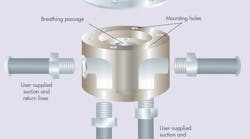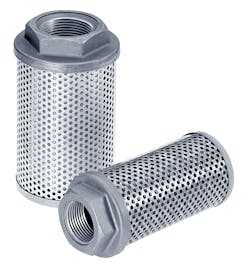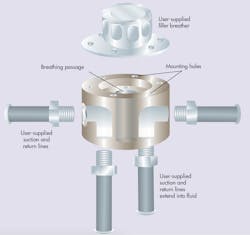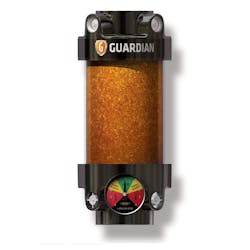The trend in hydraulic reservoirs is smaller is better. Yes, a smaller reservoir is lighter, more compact, and less expensive to manufacture and maintain than one of traditional size. But downsizing a reservoir usually requires compensating for the benefits of not having the luxury of space. For example, smaller reservoirs have less surface area for heat transfer. And in particularly dirty environments, contaminants can collect on the reservoir top to act as insulation. This reduces the effective heat transfer area from the top of the reservoir, so reservoir sides may actually be the most effective heat transfer surface. A tall and narrow geometry can be an effective solution that also conserves floor space. If this is not practical, a heat exchanger may be needed to keep fluid temperature within specified guidelines.
Diffusers Slow Things Down
When going smaller with reservoirs, however, several other considerations must be kept in mind. Going too small can allow aerated fluid to be drawn into the pump. This could cause cavitation and lead to pump damage or premature failure. When specifying a small reservoir, consider installing a flow diffuser, which reduces the velocity of return fluid (typically to 1 ft/sec), helps prevent foaming and agitation, and reduces disturbances at the inlet.
A return-line flow diffuser is typically installed in the reservoir at the end of the return line or return filter. Most designs use two concentric, perforated steel tubes. The tubes are positioned so that the perforations are offset to each other, dispersing and slowing down the return oil so air contaminants can settle out. Proper specification prevents the formation of foam and can even reduce noise generated by reservoir.
Return-line mounted flow diffusers are an effective way to help remove air from hydraulic fluid, thereby reducing foam. (Courtesy: www.stauffusa.com)
Diffusers are an effective supplement to return-line filters with threaded outlets. They can connected directly to the return line or to the filter bowl of an internally threaded filter housing. Diffusers must be positioned completely underneath the minimum liquid level of the reservoir, ideally with the closed surface of the outer steel tube facing the pump suction inlet. This prevents the return fluid from taking a “short-circuit” path directly to the pump suction.
Offline Filtration
Another big trend in reservoir design is offline filtration, often referred to as a kidney loop. The traditional practice of specifying a large reservoir was to provide enough fluid volume for heavy contaminants to settle onto the bottom of the reservoir. The thought was that letting contaminants settle on the reservoir floor kept them form circulating within the hydraulic system. But today, most filtration experts advise that it’s best to remove contaminants for the hydraulic system rather than letting them remain in the reservoir.
Providing an auxiliary inlet and outlet port on the reservoir allows connecting hose or tubing for a kidney loop—consisting of a circulating pump, filter housing, and heat exchanger, when needed. Retrofitting a kidney loop onto an existing reservoir can be difficult because inlet and outlet ports must be located well below the minimum fluid level. This means the reservoir generally has to be drained before work can begin.
However, Tom Nell, certified fluid power engineer at Flpwr.com, developed an adapter that contains the necessary connections to draw fluid from—and return fluid to—the hydraulic reservoir. The adapter makes it easy to tap into an existing hydraulic fluid in the reservoir to add a kidney loop or other auxiliary circuit.
Offline filtration circuits are an effective way of keeping fluid clean and dry in the reservoir. The device shown here allows adding a circuit to a reservoir without having to drain fluid. (Courtesy: flpwr.com)
The adapter fits between the reservoir and filler breather and incorporates a pair of SAE-12 ports that each lead to a ¾-in. vertical tube, which extends down into the hydraulic fluid. One tube is used for suction and the other for return simply by connecting the kidney loop’s inlet and outlet lines to the respective port. The ports also can be used to add fresh fluid to the reservoir without having to remove the filler-breather cap, which would open the reservoir to the atmosphere.
Keeping Dirt and Moisture Out
Most hydraulic contamination experts would agree that an ounce of prevention is worth a pound of cure. This certainly holds true with hydraulic reservoirs, where a standard filter-breather can be a major entry point for dirt and moisture. The purpose of a filter-breather is to allow surrounding air to be drawn in as the fluid level in the reservoir drops during normal machine cycles. Likewise, it allows the air to escape when the level rises. The problem is, a standard filler-breather makes almost no provision to keep water out of the reservoir.
Most water drawn in through the filter-breather is in the form of moisture in the air. Once this humid air is inside the reservoir, temperature differentials can cause the moisture to condense into liquid form. Once inside the reservoir, the water is in the hydraulic system, where it can degrade hydraulic fluid and cause erratic operation and premature component failure.
Standard reservoirs also do little to keep solid contaminants out. In most cases, the filter is nothing more than a coarse wire mesh. Most provide nothing more than a course wire mesh that lets most airborne particles pass right through into the reservoir. As the fluid level in the reservoir rises and fall from normal system operation, more and more water and dirt collect.
This is where desiccant filter breathers provide much greater protection. A typical desiccant-type breather contains fine particulate filters and a bed of desiccant. As fluid level in the reservoir drops, air is drawn in through a filter element that traps particles of 2 µm and larger. The air then passes through the desiccant bed, which traps moisture, before entering the reservoir. This provides clean dry air to the head space in a hydraulic reservoir.
Desiccant filter breathers help ensure that surrounding air drawn into a hydraulics reservoir is clean and dry. This unit contains a check valve so that expelled air is not routed through the filter or desiccant bed, thereby increasing life. (Courtesy: www.whitmores.com)
A disadvantage to desiccant filler breathers is that they must be periodically monitored. Filter elements will eventually become clogged with dirt and desiccant will eventually be depleted. Some desiccant breathers reduce this drawback by incorporating a check valve. The check valve lets incoming air flow through the filter and desiccant element, but expelled air is directly out to the surrounding atmosphere. This technique extends the life of the desiccant because it is not depleted by adsorbing moisture from exhaust air.
Other Useful Accessories
Manufacturers offer a variety of other accessories that can not only prevent system malfunctions and component failures, but also extend component lie—including fluid life. Heat is a major cause of hydraulic fluid degradation. Therefore, it’s important to monitor fluid temperature as a part of routine maintenance. Temperature gauges or electronic temperature sensors often are not specified, but they can quickly pay for themselves by reducing downtime and repair costs if high-temperature operation occurs. Specifying a temperature switch to shut down a pump if fluid temperature becomes too high can be a cost-effective preventive measure.
• On the other hand, low temperatures can also cause problems. Hydraulic fluid in systems operating in unheated area in cold climates can be viscous at low temperatures. The cold, thick fluid may not flow freely into the pump suction line, which can result in pump cavitation. A simple solution can be to specify a multigrade hydraulic fluid (fluid with a high viscosity index). Multigrade fluid maintains a consistent viscosity over a wide temperature range. However, depending on how much fluid is used in the system, and be an expensive solution.
• Another solution is to use a thermostacially controlled fluid heater. The thermostat activates the heater when temperatures are below a prescribed minimum, then shut off the heater when fluid approaches normal operating temperature. By wiring the thermostat into the system control, machine operation can be prevented until fluid reaches a minimum temperature.
• Monitoring fluid level follows a similar strategy. Because fluid level can vary widely during operation of a hydraulic system, continuous monitoring of fluid level usually is not necessary. However, specifying a switch to signal when fluid level becomes dangerously low can prevent catastrophic and expensive repairs.
•A fluid-level indicator should be located at each filler. Indicators should have high and low levels marked against a contrasting background to help maintain appropriate fluid level. An electronic level indicator can serve as a more sophisticated alternative. These devices use a variety of means to measure liquid level. Transducers produce a continuous output, and switches signal when liquid reaches a predetermined high or low level.
• Magnets can be placed in the reservoir to capture and remove metallic particles from the fluid stream. Fluid returning to the reservoir should be routed past in-tank magnets to collect as many ferrous particles as possible. Magnets should be checked periodically and cleaned to ensure continued maximum performance. Again, many filtration experts not allowing contaminants to remain in the hydraulic system, so use discretion when specifying magnets.
Some companies, however, offer magnets that wrap around the outside of a spin-on filter element. The magnet traps any particles that enter the filter, and the trapped particles are removed when the element is replaced. The wrap-around magnet can then be used on the new element.
• Although hydraulic filters are usually not considered reservoir accessories, almost all pump inlet strainers are located within the reservoir. Because the inlet strainer is out of sight, a differential pressure gauge can indicate when the strainer needs to be cleaned or replaced. The gauge should be monitored regularly (or better yet, install a differential pressure switch to shut down the motor if a threshold is exceeded) to prevent the pump from cavitating if the suction strainer becomes clogged.
We recently published an article on this technique, which you can view here.
The Many Detriments of Water
As pointed out, water getting into a hydraulic system can degrade hydraulic fluid, cause erratic operation, and cause components to fail long before their rated life. But water in a hydraulic system’s reservoir can cause another common problem—rust. Most hydraulic reservoirs are made of steel, so water in the hydraulic system can cause the interior surfaces of the reservoir to rust. Rust particles will find their way into the hydraulic fluid to wreak havoc on pumps, valves, and other key components unless they are trapped by filters. Pump manufacturers generally recommend not using a filter on pump suction lines, so a coarse screen may be the only protection for the pump.
Stainless steel reservoirs could be used, but they are usually are too expensive to be practical. The IFH Group, Rock Falls, Ill., offers a more cost-effective solution: aluminized steel. Aluminized steel is sheet steel hot-dip coated on both sides with an aluminum-silicon alloy. It solves the contamination problems inherent to uncoated steels by combining the corrosion resistance of aluminum with the structural strength (and lower cost) of steel.
Ryan McCarty of the IFH Group explains that aluminized steel reservoirs are compatible with virtually all petroleum-based and synthetic fluids while providing protection from atmospheric corrosion. Each reservoir is customized to meet application requirements and is available in capacities from 1 to more than 300 gal.
According to McCarty, “Custom made hydraulic reservoirs have an advantage over off-the-shelf units because they are designed to fit the exact space and technical requirements necessary for the optimal performance of the end product. When you’re 100 ft in the air working on 500 kV transmission lines from a telescopic aerial work platform, nothing less than optimal performance will do.”
The IFH Group manufactures reservoirs and tanks for fuel and other fluids. Materials range from mild steel, stainless steel, and aluminum, to aluminized steel. “We use whichever material is best suited to the application,” adds McCarty, “whether it’s a forklift, combine, boom crane or a specialized military vehicle.”
The company can provide powder coating, CARC (chemical agent resistant coating) and sub-assembly, including the addition of component parts such as fill caps, filler breathers, filters, sight gauges, sending units, hoses, and more. “We offer everything from a simple two-part tank strap to hydraulic reservoir tanks with more than 60 different parts,” notes McCarty. “The more we provide, the fewer vendors the customer needs to use.”





